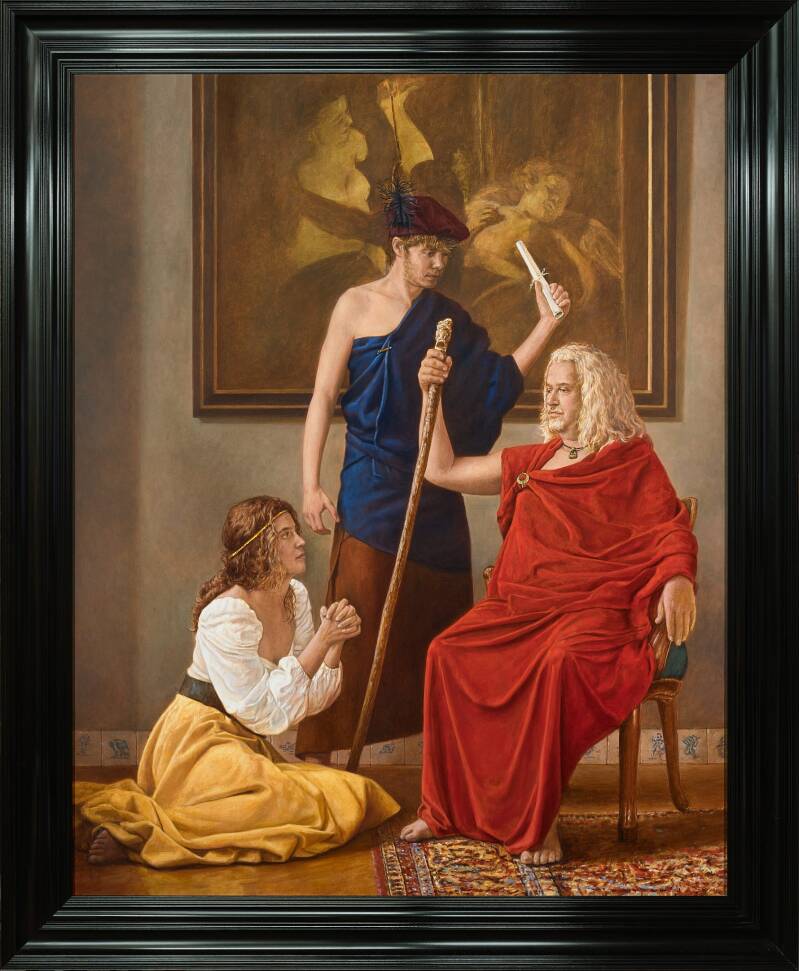Johannes Vermeer (1632-1675)

Venus, Jupiter and Mercury
"There is nothing left for me but through your reports to publicly award a bounty for the honest finder."
And with those words she handed him a form, with Psyche's name and further details on it. As soon as that was done, she returned home immediately." (an excerpt from: Amor and Psyche - Apuleius)
For Vermeer's lost painting entitled Venus, Jupiter and Mercury, I chose a scene in which Venus almost implores her complaint about the far too beautiful Psyche to the supreme god Jupiter. Jupiter ponders her complaint and Mercury, the messenger, is already in the starting position with the aforementioned pamphlet to search for Psyche.
I painted this painting in 2022 for the television program "the New Vermeer" that aired on NPO1 in early 2023. I was one of the Master painters invited to make a reconstruction of this ancient mythological theme.
Beforehand, I was not very happy with this assignment, because I could not approach my great example Johannes Vermeer (1632 - 1675) in his characteristic way. The few history paintings he made (including his presumably last painting, Allegory of Faith) are a-typical of Vermeer and, to be honest, are somewhat less appealing to me.
As I explored content and compositional ideas, using compositional models that Vermeer must also have known, I soon came to the conclusion that I had to deviate from the commission if I wanted to get close to Vermeer. I experienced increasing freedom and decided to take it; after all, everything about the commission is arbitrary and speculative.
The first was the radical adaptation of the composition. Whereas the Diana has five people and therefore a landscape format makes sense, I had to deal with three people. Although I decided to keep the specified format, I decided to put the painting upright. The standing format gave me the compositional possibility to place the figures larger in the picture plane; with a landscape format they would have become little figures and I would have had to deal with an enormous residual space. I then decided to paint a kind of fictional transitional work with various elements from Vermeer's oeuvre.
A painting about Amor and Psyche from around 1642, painted by the Frenchman Trophime Bigot (1579-1650) working in Rome, served as a reference to the actual theme. Bigot -the candlelight painter- produced work inspired by both Caravaggio and the Utrecht painter Gerard van Honthorst. The work of the Utrecht Caravaggists was certainly familiar to Vermeer, so perhaps also that French follower? Who can say? After all, Vermeer was also an art dealer.
Since it seems implausible to me that Vermeer would have painted nudes or semi-nudes in a grand landscape, complete with doves, floats, and other fixed attributes, I limited myself to subtle references. I incorporated the lightning bolt into Jupiter's medallion, the eagle and other references I depicted on Delft blue tiles, and Mercury's helmet with wings became a hat with a feather.
I chose a striking yellow garment for Venus because the color yellow is also known in popular symbolism as the color of hate, envy and jealousy, among other things.
Instead of lead-titanium yellow, I used nickel-titanium yellow and also Indian yellow to approximate Vermeer's use of color. I used as many of the colors Vermeer also used as possible anyway, including authentic lapis lazuli, yet inextricably linked to Vermeer.
For the underpainting I used various ochers and umber, and for the build-up I consulted unfinished paintings by Da Vinci to give the whole even more of an Italian feel. The figures are portrayed full-length, the space is deliberately left shallow and that too fits in with Vermeer's early working method in which space still remained subordinate.
Although I did not strictly adhere to the commission, I did create a painting that I fully support. I made it with my heart and in doing so I remained in the mindset of Vermeer: he too did things just a little differently than his contemporaries, and I also wanted to express that mysterious aspect of "The Sphinx of Delft".
Arjan van Gent | Artist


Photo in the NY Times showing me on the left in the photo during Vermeer expert Pieter Roelofs' master class.

At the Rijksmuseum amid Pieter Roelofs and Mauritshuis conservator (and Vermeer researcher) Abbie Vandivere. In the background "Diana and Her Nymphs" by Johannes Vermeer from the Mauritshuis collection.

Posing in front of my "Vermeer" at the Vermeer Center in Delft. The painting will have a permanent home at the center in March 2025.


Revealed by filmmaker, writer and artist Peter Greenaway during the opening of the exhibition Vermeer by a New Generation. Greenaway was invited to this special unveiling because his daughter Pip was the model for Venus.
Photography: Ingrid Goudswaard

